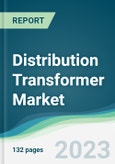The global distribution transformer market is estimated to grow at a CAGR of 6.5% during the forecast period.
Distribution transformers are designed to reduce the voltage from the high-voltage transmission lines to a lower level, typically ranging from a few hundred to a few thousand volts, depending on the local distribution system's requirements. A distribution transformer consists of the following types such as single-phase, three-phase, pad-mounted, and pole-mounted types. It is used in residential, commercial, and industrial settings to step down high-voltage electricity to a lower voltage level suitable for safe consumption. The increasing electricity demand in residential and industrial settings and the growing adoption of smart grids boost the demand for distribution transformers, propelling market growth.The growing demand for electricity in the residential and industrial sectors is expected to boost market growth.
The increasing urbanization, rising population, and improving living standards are driving the need for reliable and efficient power distribution infrastructure. There is a rise in household electricity demand for powering various appliances owing to which there is a corresponding increase in the demand for distribution transformers to step down high-voltage electricity to a level suitable for residential consumption. Industrial facilities require substantial amounts of electricity to power heavy machinery, manufacturing processes, lighting, HVAC systems, and other electrical equipment. Distribution transformers play a crucial role in delivering electricity efficiently and safely to industrial establishments, stepping down the voltage from the distribution grid to levels compatible with industrial equipment requirements. The rising need for electricity in the residential and industrial sectors drives the demand for distribution transformers. For instance, according to the United Nations Environment Programme 2020 Global Status Report for Buildings and Construction, in 2020, 22% of global electricity was used by residential buildings. According to the Nuclear Energy Agency (NEA) in 2022, the primary, secondary, and tertiary industries in China consumed 114.6 TWh, 5,700.1 TWh, and 1,485.9 TWh respectively in 2022, marking year-on-year increases of 10.4%, 1.2%, and 4.4% respectively. This shows that distribution transformers have a great demand in the coming days.The surge in the adoption of smart grids propels the distribution transformer market growth.
Smart grids utilize advanced technologies and communication systems to optimize the generation, distribution, and consumption of electricity. Distribution transformers support voltage control in smart grids, and they play a crucial role in regulating voltage levels to ensure a consistent and stable power supply to end consumers. This capability helps to maintain optimal voltage profiles across the grid, minimizing power quality issues and improving the overall reliability of the electrical supply. The increasing adoption of smart grids accelerates the demand for distribution transformers. According to the International Energy Agency (IEA) in 2022, about USD 20?billion had been allocated by governments globally for the development of smart grids.The Asia-Pacific region is expected to hold a significant market share during the forecast period.
The Asia-Pacific region will account for a major share owing to the increased industrialization, and electricity consumption in countries like China and India, coupled with rising adoption of smart grids. In September 2021, the Government of the United Kingdom announced that it will invest US$ 1.2 billion through public and private investments in green projects and renewable energy in India to support the latter’s target of 450 GW of renewable energy by 2030 which will increase the electricity production in the country. In 2020, the State Grid Corporation of China invested almost 461 billion yuan in the development of smart grid technology. Such progressive developments boost the demand for distribution transformers, thereby bolstering their regional market growth.Key Developments
- February 2023: Servokon introduced a 16,000 KVA power and distribution transformer which was a major step towards fulfilling the Indian government's vision to revamp the power infrastructure in the country and make India energy independent.
- January 2023: Franklin Electric launched INCON® Distribution Transformer Monitor which provides a meter-grade precision performance monitoring of high-value, mission-critical, low voltage pad mount transformers and conventional pole top transformers.
- August 2022: HPS launched low-voltage distribution transformers with standard 10kV BIL rating for increased reliability and protection against critical equipment failure and are expected to reduce energy losses by an average of 18%.
Segmentation
By Mounting Type
- Pad-Mounted
- Pole-Mounted
By Phase
- Single Phase
- Three Phase
By End-User
- Residential
- Commercial
- Industrial
By Geography
- North America
- USA
- Canada
- Mexico
- South America
- Brazil
- Argentina
- Others
- Europe
- Germany
- UK
- France
- Spain
- Others
- Middle East and Africa
- Saudi Arabia
- UAE
- Others
- Asia Pacific
- China
- Japan
- South Korea
- India
- Australia
- Other
Table of Contents
1. INTRODUCTION
2. RESEARCH METHODOLOGY
3. EXECUTIVE SUMMARY
4. MARKET DYNAMICS
5. DISTRIBUTION TRANSFORMER MARKET ANALYSIS, BY MOUNTING TYPE
6. DISTRIBUTION TRANSFORMER MARKET ANALYSIS, BY PHASE
7. DISTRIBUTION TRANSFORMER MARKET ANALYSIS, BY END-USER
8. DISTRIBUTION TRANSFORMER MARKET ANALYSIS, BY GEOGRAPHY
9. COMPETITIVE ENVIRONMENT AND ANALYSIS
10. COMPANY PROFILES
Companies Mentioned
- CG Power & Industrial Solutions Ltd.
- General Electric
- HYOSUNG HEAVY INDUSTRIES
- MGM Transformer Company
- Siemens
- Southwest Electric Co
- Transcon Industries
- Virginia Transformer Corporation
Methodology

LOADING...








